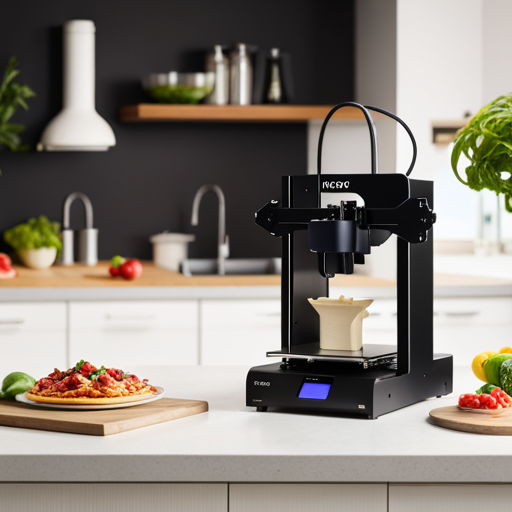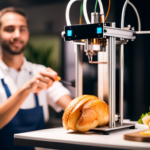In the rapidly evolving landscape of the food industry, 3D printing technology has emerged as a transformative force, akin to a culinary alchemist’s tool.
This article presents a comprehensive competitive analysis of the food 3D printing sector, delving into market dynamics, key industry players, technological advancements, and future prospects.
Through a holistic examination, readers will gain valuable insights into the competitive landscape and strategic positioning within this innovative and dynamic industry.
Market Overview
The food 3D printing industry is experiencing rapid growth, with an increasing number of companies entering the market to capitalize on the emerging technology. This growth is driven by a variety of industry insights and consumer preferences.
Industry insights reveal a shift towards personalized nutrition and the demand for sustainable food production methods. Consumers are increasingly seeking customized food options tailored to their dietary needs and preferences, and 3D printing technology offers the potential to meet these demands. Additionally, there is a growing interest in the visual and sensory appeal of 3D printed food, indicating that consumer preferences are not solely based on taste and nutrition but also on the overall experience of consuming food.
As the market continues to evolve, key industry players are at the forefront of shaping the future of food 3D printing. These companies are driving innovation, addressing regulatory challenges, and exploring new applications for the technology. Understanding the competitive landscape and the strategies employed by these industry leaders is essential for gaining valuable insights into the dynamics of the food 3D printing industry.
Key Industry Players
The food 3D printing industry is shaped by its key industry players, comprising market leaders and innovators. Understanding their market share and growth strategies is crucial for comprehending the competitive landscape.
Additionally, analyzing their technological advancements and patents provides insight into their long-term sustainability and competitive positioning.
Market Leaders and Innovators
Prominent companies and pioneering innovators are shaping the landscape of the food 3D printing industry. In a field marked by intense market competition, these industry pioneers continue to drive innovation and set new standards for the future of food production.
Key industry players include:
-
Natural Machines: Known for their Foodini 3D food printer, this company is at the forefront of creating healthy and sustainable food options through 3D printing technology.
-
BeeHex: With their Chef 3D printer, BeeHex is revolutionizing the way food is prepared and presented, offering customizable and intricate designs for various culinary applications.
-
3D Systems: A global leader in 3D printing, 3D Systems has made significant strides in the food industry with their ChefJet Pro printer, enabling the creation of intricate edible designs and confections.
-
Print2Taste: This company has gained recognition for its Bocusini 3D food printing system, which caters to both professional chefs and food enthusiasts, allowing for the creation of personalized culinary creations.
These market leaders and innovators are continuously pushing the boundaries of food 3D printing, paving the way for a more dynamic and sustainable food ecosystem.
Market Share and Growth
Continuing to drive innovation and expand their market presence, key industry players in the food 3D printing sector are actively seeking to solidify their market share and achieve sustained growth.
Market trends indicate a growing consumer preference for personalized and nutritious food options, which has been a driving force behind the expansion of the food 3D printing industry. Companies are strategically positioning themselves to capitalize on this shift in consumer behavior, aiming to secure a larger market share by offering innovative and customizable 3D printed food products.
Moreover, the increasing adoption of 3D printing technology in the culinary world is propelling the market’s growth, with key industry players investing in research and development to introduce advanced printing techniques and broaden their product portfolios.
As a result, the food 3D printing landscape is witnessing heightened competition and dynamic market expansion.
Technological Advancements and Patents
Key industry players in the food 3D printing sector are spearheading significant technological advancements and securing patents to establish their competitive edge. This is evident in the current patent landscape and the development of advanced 3D printing materials. Notable advancements and patents include:
- Novel 3D printing techniques that enable the creation of intricate food designs with precise control over texture and taste.
- Patented food-grade 3D printing materials that comply with safety standards and enhance the quality of printed food products.
- Innovative software solutions for customizing food designs and optimizing the 3D printing process for different culinary applications.
- Patents related to the integration of robotic systems and artificial intelligence for automating food 3D printing workflows.
These developments reflect the industry’s commitment to innovation and the creation of unique value propositions.
As the food 3D printing industry continues to evolve, these technological advancements play a pivotal role in shaping the competitive landscape and driving future growth.
Technological Advancements
In recent years, significant technological advancements have propelled the food 3D printing industry into a new era of innovation and efficiency. This progress has been particularly notable in the development of new 3D printing materials and software tailored specifically for food applications. These advancements have expanded the possibilities for creating intricate and customized food designs while improving the overall user experience. The following table highlights some of the key technological advancements in the food 3D printing industry:
| Technological Advancements | Description | Impact |
|---|---|---|
| Advanced 3D Printing Materials | Introduction of edible and food-safe materials | Enhanced safety and quality of printed food |
| Specialized 3D Printing Software | Tailored software for food design and printing | Streamlined workflow and precise customization |
| High-Speed 3D Printing | Accelerated printing processes | Increased efficiency and production speed |
These technological advancements have not only facilitated the production of more complex and diverse food products but have also improved the overall safety and efficiency of food 3D printing processes.
Market Trends Analysis
The food 3D printing industry is experiencing a notable shift in market trends, reflecting evolving consumer preferences and technological advancements. This analysis of market trends highlights several key developments:
-
Customization: There is a growing demand for personalized and customizable food options. Consumers are increasingly seeking unique and tailored dining experiences, and 3D food printing technology allows for the creation of intricate and personalized food products.
-
Health and Nutrition: With a rising focus on health and wellness, there is a trend towards the use of nutritious and natural ingredients in 3D printed food. Consumers are looking for options that align with their dietary preferences and nutritional requirements.
-
Sustainability: Environmental consciousness is shaping market trends, driving the adoption of sustainable practices in the food 3D printing industry. This includes the use of eco-friendly materials, reduction of food waste, and energy-efficient production processes.
-
Accessibility: As the technology advances, there is a push towards making 3D printed food more accessible and affordable to a wider consumer base. This involves efforts to streamline production processes and reduce costs, making innovative culinary experiences more accessible to the general public.
Competitive Landscape
Amidst the evolving market trends in the food 3D printing industry, a diverse and dynamic competitive landscape has emerged, reflecting the increasing interest and investment in this innovative sector. Competitive analysis within the industry reveals a growing number of players vying for market share and technological leadership.
Established food companies, tech startups, and 3D printing manufacturers are all entering the fray, each bringing their unique strengths and resources to the table. This has led to a surge in industry competition, driving innovation and pushing the boundaries of what is possible with food 3D printing technology.
In this competitive landscape, companies are not only focusing on improving the speed and accuracy of 3D food printing but also on expanding the range of printable ingredients, ensuring food safety standards, and developing user-friendly interfaces for consumers. Additionally, there is a significant emphasis on sustainability, with many competitors striving to reduce food waste and environmental impact through 3D printing processes.
As a result, the industry is witnessing a rapid evolution, characterized by intense competition and a relentless pursuit of advancement in 3D food printing technology.
SWOT Analysis
Evolving alongside the competitive landscape of the food 3D printing industry, a SWOT analysis provides a comprehensive evaluation of the strengths, weaknesses, opportunities, and threats shaping the market dynamics.
-
Strengths
- Customization: Food 3D printing offers the ability to create personalized and intricate designs, catering to individual preferences and dietary restrictions.
- Innovation: The technology fosters culinary creativity, enabling the development of novel food textures, flavors, and presentations.
-
Weaknesses
- Limited Materials: Current food 3D printing is constrained by the types of edible materials that can be used, restricting the range of food products that can be printed.
- Speed: The slow printing process may not align with the fast-paced demands of commercial kitchens and food production.
-
Opportunities
- Health and Nutrition: There is potential to use 3D printing to produce nutritious and functional foods tailored to specific health needs.
- Sustainable Practices: 3D printing can support sustainability efforts by reducing food waste and enabling precise portion control.
-
Threats
- Regulatory Hurdles: Adhering to food safety regulations and obtaining necessary certifications poses a challenge for widespread adoption.
- Cost: The initial investment and operational costs of food 3D printing technology may be prohibitive for some businesses.
Future Prospects
As the food 3D printing industry continues to evolve, it is essential to assess the future prospects that lie ahead.
The market growth potential presents exciting opportunities for companies to expand their reach and offerings.
Furthermore, the impact of technological advancements and the emergence of new market opportunities are crucial factors to consider in shaping the future landscape of the industry.
Market Growth Potential
The market growth potential in the food 3D printing industry shows promise for substantial expansion in the coming years. This is evident from the following market trends and emerging opportunities:
-
Increasing Adoption: The growing acceptance of 3D printing technology in the food industry is driving market expansion.
-
Diversification of Offerings: The industry is witnessing a shift towards the production of a wide range of food products, including confectionery, snacks, and even personalized nutrition.
-
Technological Advancements: Ongoing innovations in 3D printing techniques and materials are opening new possibilities for the industry, attracting investment and fostering growth.
-
Global Reach: The market’s potential for expansion is further strengthened by the increasing penetration of food 3D printing technologies in various regions, indicating a broader market scope.
Technological Advancements Impact
Amidst the evolving landscape of the food 3D printing industry, technological advancements are poised to significantly impact its future prospects, driving innovation and expanding the range of feasible applications. These advancements will revolutionize the way food is prepared, presented, and consumed, offering a myriad of potential benefits such as customization, sustainability, and efficiency. The impact of 3D printing on the food industry extends beyond novelty creations to encompass critical aspects such as nutritional personalization, culinary design, and even addressing global food security challenges. The future applications of this technology are vast, ranging from personalized nutrition tailored to individuals’ specific dietary needs to the creation of unique culinary experiences. As 3D printing technology continues to advance, its potential to reshape the food industry is becoming increasingly apparent.
| Future Applications | Impact of 3D Printing | Advantages |
|---|---|---|
| Personalized Nutrition | Culinary Design | Customization |
| Global Food Security | Nutritional Personalization | Sustainability |
| Unique Culinary Experiences | Efficiency | Innovation |
Emerging Market Opportunities
With the technological advancements in food 3D printing, emerging market opportunities are presenting themselves, offering potential for significant growth and impact within the industry.
Key areas of future prospects include:
-
Customized Nutrition: The ability to cater to individual dietary needs and preferences through personalized 3D printed food products.
-
Mass Customization: Leveraging emerging technologies to enable large-scale production of customized food items at an affordable cost.
-
Sustainable Food Solutions: Meeting the increasing consumer demand for sustainable and eco-friendly food options through 3D printed plant-based alternatives.
-
Medical and Elderly Care: Addressing the specific nutritional requirements of patients and elderly individuals by developing specialized 3D printed food products tailored to their needs.
These emerging market opportunities demonstrate the potential for food 3D printing to not only meet but also shape consumer demand in the future.
Frequently Asked Questions
What Are the Potential Ethical and Environmental Implications of Using 3D Printing Technology in the Food Industry?
The use of 3D printing technology in the food industry raises potential ethical implications regarding food safety, consumer choice, and equitable access. Additionally, there are environmental impacts related to material waste and energy consumption in the production process.
How Are Regulations and Food Safety Standards Impacting the Adoption of 3D Printing in the Food Industry?
Regulatory impact on 3D printing in the food industry is significant. Compliance with food safety standards is paramount for adoption. While regulations can be seen as barriers, they also ensure consumer safety and drive industry innovation.
What Are Some of the Unique Challenges and Opportunities for Small and Medium-Sized Businesses Entering the 3D Food Printing Market?
Entering the 3D food printing market presents unique challenges for small and medium-sized businesses, such as high initial investment and technical expertise. However, it also offers opportunities for innovation, customization, and meeting niche market demands in the food industry.
How Are Consumer Preferences and Cultural Differences Influencing the Development of 3D Printed Food Products?
Consumer behavior and cultural influences play a pivotal role in shaping the development of 3D printed food products. Understanding these factors is crucial for businesses to align their technological advancements, market trends, and business strategies in the face of global competition.
What Role Do Partnerships and Collaborations Play in Driving Innovation and Growth Within the Food 3D Printing Industry?
Partnership opportunities and collaborative innovation are essential in driving growth and fostering innovation within the food 3D printing industry. Through strategic alliances and joint ventures, companies can leverage complementary strengths to advance technology and expand market presence.
Conclusion
In conclusion, the competitive analysis in the food 3D printing industry reveals a dynamic market with key players driving technological advancements and shaping market trends.
The industry’s competitive landscape is characterized by diverse strengths, weaknesses, opportunities, and threats.
As the industry continues to evolve, future prospects for growth and innovation appear promising.


